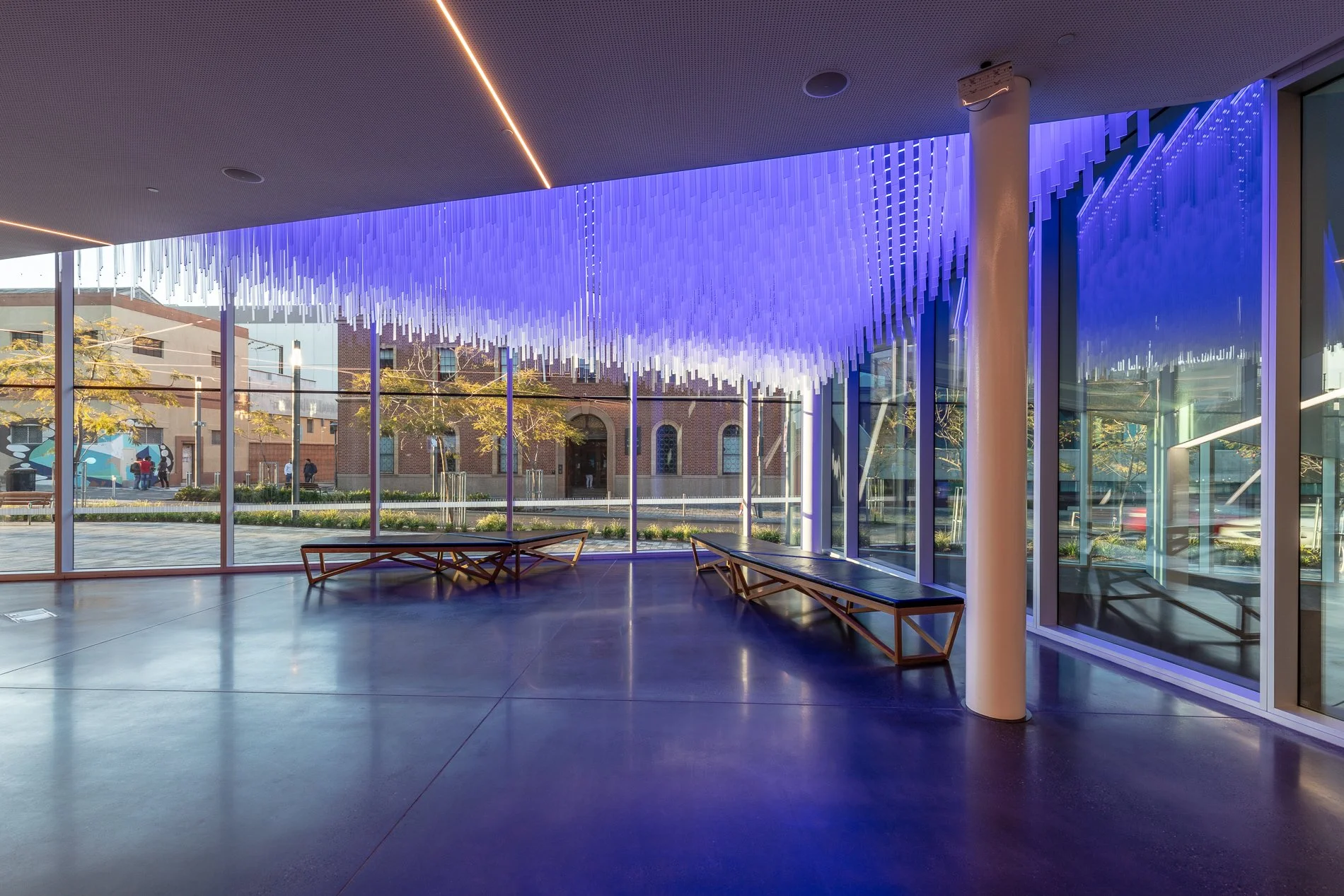Feature... The (super)power of Collaboration: The SA Creative Collaboration Prize
Pridham Hall. Photographer: Andre Castellucci.
In South Australia, some of our most evocative spaces are born from conversations between architects, artists, makers and designers. The newly launched SA Creative Collaboration prize, an initiative of the Australian Institute of Architects’ (RAIA) SA Chapter in partnership with JamFactory, celebrates these creatives exchanges.
Words Dr Nathan James Crane
The prize not only values the outcome but the shared process, cultural exchange, and embedded artistry that shape the built environment, highlighting how collaboration transforms both projects and communities for their mutual betterment.
Announced recently at the 2025 SA Architecture Awards, the Prize is the first of its kind nationally. It places process at the centre, honouring not just the final built work but the relationships, negotiations, and creative frictions that shape it. In an era where design disciplines increasingly converge, this award signals a shift: valuing not only the “what” of design but the “how” and “with whom.”
The premise is deceptively simple yet profound, celebrating architectural projects that are born of genuine collaboration between architects and other creative practitioners, from artists and designers to craftspeople and cultural producers. The aim is to recognise projects that demonstrate new connections, shared knowledge, expanded processes, and tangible benefits to culture and community. In doing so, the Prize reinforces that architectural excellence is not only measured in awards juries and glossy spreads, but also in how it fosters relationships, deepens cultural narratives, and embeds artistry in daily life. This behind- the-scenes working is so often uncelebrated, and yet – arguably – it is the linchpin to creating nuanced and resonant creative experiences for both designer and inhabitant.
Pridham Hall. Photographer: Andre Castellucci.
THE PROOF IS IN THE PROCESS
South Australia has long been a fertile ground for these kinds of cross-disciplinary ventures. The 2023 exhibition of Frida & Diego: Love & Revolution at the Art Gallery of South Australia is a vivid example. Here, Grieve Gillett Architects worked closely with AGSA’s curatorial team to create an exhibition design that transported visitors into the colour-saturated, politicaly charged atmosphere of mid-century Mexico. The collaboration extended well beyond spatial planning, encompassing scenography, material tactility, and an acute sensitivity to cultural storytelling. The result was an immersive environment that was as integral to the exhibition’s success as the artworks themselves, contributing to its national profile and furthering Adelaide’s position as a cultural destination (the exhibition was AGSA’s strongest performing single exhibition post-Covid with over 83,000 visitors in 12-weeks).
Equally revealing is the story of Pridham Hall (coincidentally a project I covered in a previous Marmalade, Issue 06, in 2018), which embodies the benefits of collaborative thinking from day one. Conceived and delivered by JPE Design Studio in collaboration with Snøhetta and the artisan teams at JamFactory, the Hall is more than a university facility, it is a civic space animated by craft. The integration of locally designed and made elements is not a decorative afterthought, but intrinsic to the building’s identity. In its timber detailing, metalwork, and lighting, one reads the fingerprints of makers. The building’s resonance lies in this embedded artistry, which transforms a campus facility into an authentic space of belonging and pride.
These projects speak to a truth that is often overlooked: collaboration is not an “add- on” to design, nor a late-stage commission to tick a cultural box. It is most potent when it is foundational, when the conversation between architect and maker, designer and client, is initiated early and given the space to evolve.
SHAPING THE NEXT CHAPTER
The SA Creative Collaboration Prize is as much about shaping the future as it is about celebrating the present. It invites architects and collaborators to explore non- traditional methodologies and speculative work, creating a platform for experimental practice to be recognised alongside the built environment.
For Brian Parkes, CEO of JamFactory, the Prize reflects a long-standing belief in the role of craft and design in public life. “Embedding creative practice in the built environment,” he notes, “ensures that artistry is not confined to the gallery but becomes part of our everyday experience.” This is not mere rhetoric; it is an economic and cultural strategy. Embracing makers and other creatives within design project teams enriches architectural process and thinking: the outcome is a richer, nuanced environment for occupants. Moreover, by commissioning local makers for architectural projects, the profession directly sustains creative livelihoods and strengthens South Australia’s position as a centre for craft and design.
A CATALYST FOR CULTURAL EXCHANGE
What makes this Prize unique within the Australian context is its scope. It not only validates the role of collaboration in producing exceptional architectural outcomes, it also broadens the lens of what architecture can be. It recognises that innovation often occurs at the margins, where disciplines overlap and challenge each other.
As Josephine Evans, Chair of the Creative Alliance Committee, succinctly puts it, “Great design is often the result of a shared vision…” The Prize ensures that this shared vision is not only acknowledged but actively championed, setting a precedent for how we might build, make, and imagine together.
For South Australia, this is an opportunity to leverage its scale and interconnected creative community. Unlike larger markets where specialisation can lead to siloed thinking, the state’s design culture thrives on proximity and shared resources. Architects here are as likely to be in conversation with a ceramicist as with an engineer. This is not incidental; it is a strength (and a superpower) to be harnessed, now and into our collaborative future(s).
Join the registry and find out more about the SA Creative Collaboration Prize and how to enter at architecture.com.au


